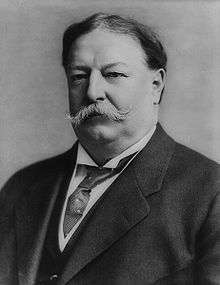Mann–Elkins Act
The Mann–Elkins Act was a 1910 United States federal law that was among the Progressive era reforms.[1] The Act extended the authority of the Interstate Commerce Commission (ICC) to regulate the telecommunications industry, and designated telephone, telegraph and wireless companies as common carriers.[2]:216 During President William Howard Taft's administration, the federal government moved to strengthen its regulatory control over the railroad industry by the passage of the Mann–Elkins Act.
Supported by Taft, the law also expanded on the powers granted to the ICC in the 1906 Hepburn Act. The ICC was authorized to investigate proposed railroad rate increases and suspend them if warranted. The "long-and-short haul" clause of the original Interstate Commerce Act (1887) was strengthened to prohibit railroads from charging passengers more for a short distance trip, compared to a longer distance ride, over the same route, unless specifically approved by the ICC.[2]:217–219
The Act also created the short-lived United States Commerce Court for adjudication of railway disputes.[2]:216 The Court presided until 1913, when it was abolished by Congress.[3][4]
Legislative history
It was passed by the United States Senate, 50-12.
See also
References
- ↑ United States. Mann-Elkins Act, 61st Congress, 2nd session, ch. 309, 36 Stat. 539, enacted June 18, 1910.
- 1 2 3 Sharfman, Isaiah L. (1915). Railway Regulation: An Analysis of the Underlying Problems in Railway Economics from the Standpoint of Government Regulation. Chicago: La Salle Extension University.
- ↑ U.S. Urgent Deficiency Act, 63rd Congress, 1st session, ch. 32, 38 Stat. 208, October 22, 1913. Effective December 31, 1913.
- ↑ Gilmore, Eugene A.; Wermuth, William C. (1917). "III. The Various United States Courts and their Jurisdiction: The Commerce Court (Abolished).". Modern American Law. Chicago: Blackstone Institute. pp. 278–280.
